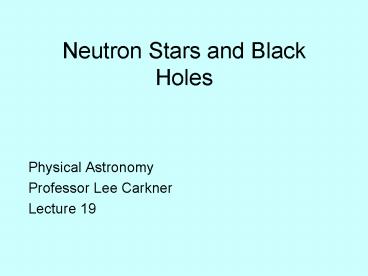Neutron Stars and Black Holes - PowerPoint PPT Presentation
1 / 16
Title:
Neutron Stars and Black Holes
Description:
As density increases neutrons 'drip' outside of nuclei. Neutron Star Structure. inner crust of heavy nuclei and free neutrons. interior mostly neutrons ... – PowerPoint PPT presentation
Number of Views:49
Avg rating:3.0/5.0
Title: Neutron Stars and Black Holes
1
Neutron Stars and Black Holes
- Physical Astronomy
- Professor Lee Carkner
- Lecture 19
2
Question
- Should there be a lower limit for the mass of
observed white dwarfs? Why or why not?
3
Neutron Stars
- Proposed in 1934 (after the discovery of the
neutron) - Very small (10 km), and thus very low luminosity
- rapidly rotating neutron star produces beamed
radio emission
4
Neutron Degeneracy
- Neutron degeneracy pressure only kicks in at
nuclear densities - Star is like a big ball of 1057 nucleons
- Also follows a mass X volume constant
relationship - Mass limit of 3 Msun
5
Neutron Star Formation
- Process hard to model
- At high densities electrons become relativistic
and combine with protons to produce neutrons (and
neutrinos) - As density increases neutrons drip outside of
nuclei
6
Neutron Star Structure
- inner crust of heavy nuclei and free neutrons
- interior mostly neutrons
- maybe a core of sub-nuclear particles?
7
Rotation
- Ratio of initial and final periods
- Pf/Pi (Rf/Ri)2
- Periods milliseconds
8
Flux Freezing
- Magnetic fields get frozen into core material
and concentrated as core shrinks - Bf/Bi (Ri/Rf)2
- Again, hard to know initial core magnetic field
- B 108 T
9
Pulsars
- P 1 sec
- Only something very small and compact could
change that fast - from asymmetrical supernova
- Can be found in the center of SNR
10
Pulsar Model
- Changing magnetic field produces magnetic dipole
radiation - If the cone intersects the Earth, we see the
radio pulse - Energy is drawn from rotation and the pulsar
slows down over time
11
Black Hole
- Above 3 Msun, core must form a black hole
- Point occurs at the Schwarzschild radius
- RS 2GM/c2
- Marks the event horizon
- At the center is the singularity
- Even outside of the event horizon, tidal forces
are very strong - Material nearing a black hole is violently ripped
apart - Can heat up material causing it to emit
12
Rotation
- Maximum angular momentum is
- Lmax GM2/c
- May cause frame dragging of local spacetime
13
Types of Black Holes
- 3-15 Msun, stellar remnant black holes
- 100-1000 Msun intermediate mass black holes
- possible explanation for superbright X-ray
sources - 105-109 Msun, supermassive black holes
- Create AGN when active, hard to find if not active
14
NS and BH Binaries
- Called an X-ray binary
- If the mass of the compact object is greater than
3 Msun, it is a black hole - More than anything else but annihilation
15
Types of Binaries
- X-ray pulsar
- Matter falls onto pulsar, heating it up to X-ray
temperatures (107 K) - X-ray hot spot may be eclipsed
- Mass transfer may spin-up the pulsar, decreasing
the period - X-ray burster
- If the magnetic field is too week the material
will build up in a layer on the surface
16
Next Time
- Read 24.2-24.4
- Homework 17.11, 17.17, 17.18, 24.15, 24.32































